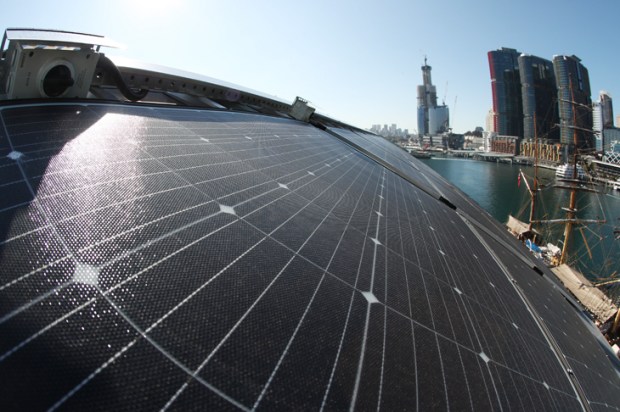There are far better ways to spend $50 billion if you really want to ‘save the planet’ than splurging it on (imported from China?) renewable energy generation.
But big business has succumbed to the IPCC-led international net zero momentum, with the Business Council of Australia demanding that the Morrison government embrace climate change evangelism by upgrading its ‘hope’ to meet net zero emissions by 2050 (under its ‘technology not promises’ approach) to pledging to do so. This is in order not only to avoid Australia getting pariah treatment at next month’s Glasgow climate summit but also, curiously, to provide investors, especially foreign financiers and superannuation fund managers, with the certainty (?) of a political commitment the delivery of which is almost 30 years away. Even more curious is BCA’s insistence on an unachievable almost doubling of Morrison’s 2030 CO2 emissions reduction target to around half the 2005 level.
With gas, a CO2 emitter, having to play an increasing role in the orderly transition from coal to renewables in the energy market for years well beyond 2030, the BCA’s proposal is no more than a facile expression of environmental purity which even net zero Liberal MPs regard as unrealistic.
As Energy Minister Angus Taylor warned last Monday, gas-fired power will continue to be required to help ‘bring more renewable energy into the mix without risking grid stability’ – and so avoiding getting things wrong, such as in the European energy squeeze and the UK’s gas crisis with industries stopped, jobs at risk, food shortages and energy bills sky rocketing.
National’s leader Barnaby Joyce dismissed BCA’s modelling-based claim that its plan would benefit Australia’s GDP by $890 billion and noted that Europe’s chaos came after modelling that turned out to be wrong – and making Australia, an exporter of fossil fuels, ‘a massive beneficiary’. And China’s electricity crisis, with power rationing threatening economic growth, has forced Beijing to (temporarily?) lift its bullying ban on Australian coal. Media reports of up to one million tonnes of Australian thermal coal that had been stranded either offshore or in store being been made available have been followed by a coal consultancy Wood Mackenzie predicting three million tonnes of thermal coal and five million tonnes of steel-making coal will be cleared from port stockpiles into domestic markets. Just as well we still have a coal industry.
Nevertheless, there is no doubting the strength of the pressure on the government to be seen to be inside the net zero emissions tent with most of our trading and close alliance partners, rather than outside it. But the blinkered focus on cutting emissions ignores the reality, as readers of this page will be aware, that the IPCC’s campaign to prevent CO2 from entering the atmosphere only deals with about half of the world’s CO2 output; the rest is absorbed naturally by land and ocean sinks, with land taking almost a third of the total.
The fact, grudgingly acknowledged by the IPCC, that land has the potential to absorb a lot more CO2 as a result of human intervention, does not appear to suit the agendas of those financial elites in the developed world who see greater benefit in ensuring emissions not be created in the first place rather than in measures to increase the capacity to absorb them out of the atmosphere. Referred to by the IPCC as Carbon Dioxide Removal (CDR), it is an alternative that would take the heat off the economically disruptive rush to end the era of fossil fuels. Such relief would not only benefit Australian fossil fuel producers, but rescue our balance of payments, to which they are major contributors, from the collapse inherent in the BCA’s plan.
There is no doubt that diverting the BCA’s $50 billion onto schemes to absorb greenhouse gasses into our land carbon dioxide sink (and coincidentally restoring degraded land, improving hydration and massively upgrading agricultural productivity) would be far more in Australia’s interests.
But not according to Big Business, especially the climate hyper-sensitive banks who no longer lend to coal, which have left it to the government to fund much-needed research in this area. And the BCA, in proclaiming its ‘support for the science of climate change’, ignores the IPCC scientific inadequacy in dealing with the issue of land carbon sinks – a matter of major significance to Australia.
While acknowledging that human intervention by way of carbon dioxide removal from the atmosphere and storing it in land sinks is necessary to reach global net zero, IPCC admits to inadequate research and lack of confidence in many of its land sink conclusions. ‘Significant uncertainty remains in the future of the global land carbon sink… land continues to dominate the overall uncertainty in the projected response of the global carbon cycle to climate change… further research is needed to understand the drivers on changes in the CO2 sink rate,’ the IPCC says in Chapter 6 of its latest report. Its incapacity to measure how much CO2 goes into land sinks has resulted in its guess simply being the residue after deducting the volume of measurable emissions that go to the atmosphere and the sea from measured total emissions.
There is little confidence in an estimated potential capacity limit that could accommodate terrestrial carbon capture, utilisation and storage of only two-thirds of the capacity that has been lost over the past 12,000 years but without sound evidence to support it.
However, the research that has been done outlines the potential benefit to the Australian economy of enhanced carbon capture and storage in soil, with the IPCC noting that not only degraded and marginal land can benefit from increased soil carbon content but this also applies to traditional agricultural lands. ‘A simple practice is to increase the input of carbon to the soil by selecting appropriate varieties or species with greater root mass or higher yields and net primary productivity. In addition, improved agricultural practices also increase soil carbon content.
These include the use of crop rotation cycles, increase the amount of crop residues, use of crop cover to prevent periods of bare soil, optimisation of grazing and residue management, use of irrigation, employment of low-tillage or no-tillage, agroforestry, and cropland nutrient recycling, and avoiding grassland conversion. Methods which seek soil carbon sequestration will diminish nitrous oxide emissions and nutrient leaching, and improve soil fertility and biological activity’.
But it does warn that CDR options based on terrestrial carbon sinks will require the appropriation of significant amounts of water. As part of Barnaby’s deal with ScoMo on zero emissions, do I detect a dam or several on the way?
Got something to add? Join the discussion and comment below.
Get 10 issues for just $10
Subscribe to The Spectator Australia today for the next 10 magazine issues, plus full online access, for just $10.
You might disagree with half of it, but you’ll enjoy reading all of it. Try your first month for free, then just $2 a week for the remainder of your first year.














Comments
Don't miss out
Join the conversation with other Spectator Australia readers. Subscribe to leave a comment.
SUBSCRIBEAlready a subscriber? Log in